Numismatic Articles
Van Arsdell 2014g (Info)
Modern Celtic Fakes 6 – an “obvious” fake
By Robert Van Arsdell
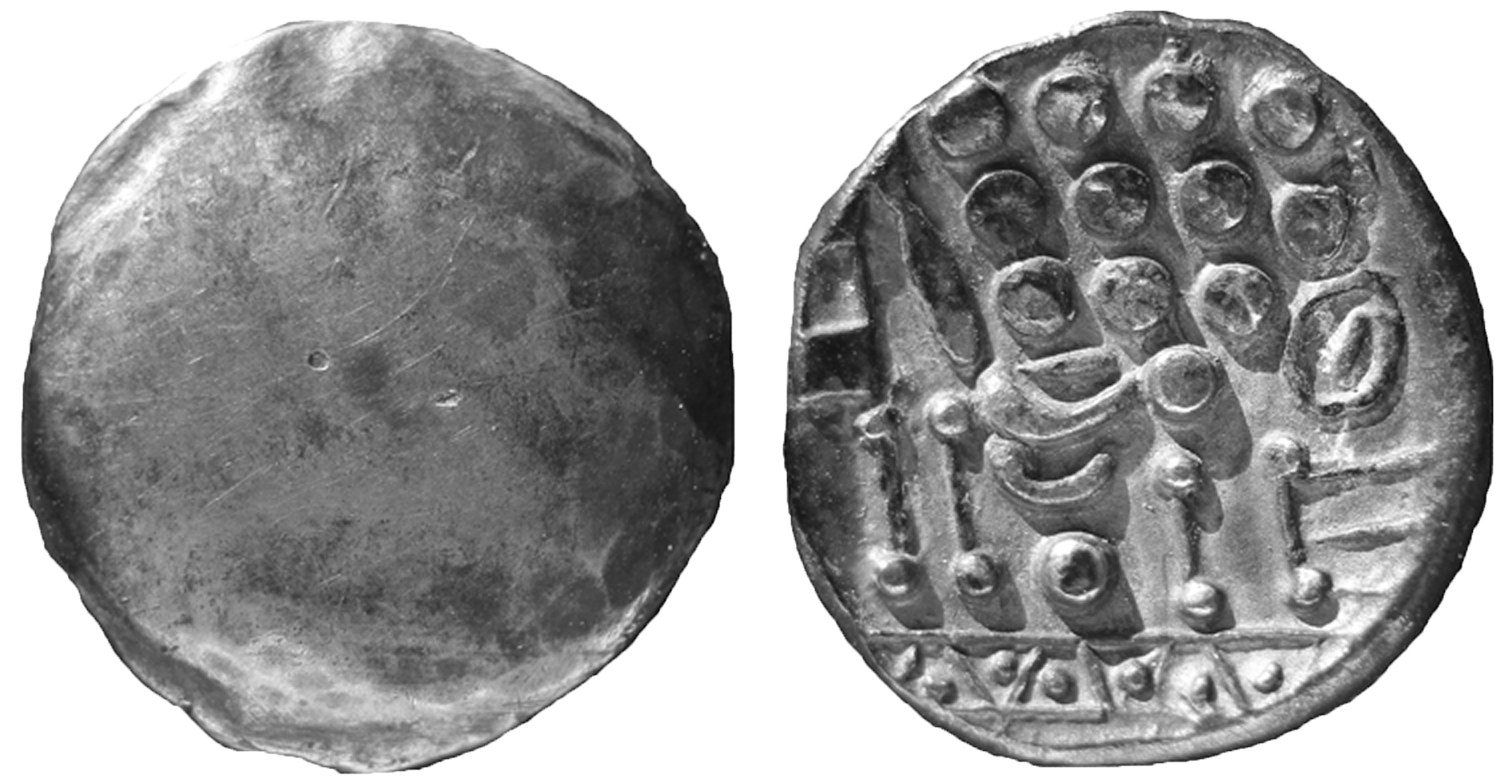
The coin shown above is a modern forgery of a Durotrigan silver stater. Paul Withers was the first to question its authenticity and bring it to my attention in March 1989. The coin proved to have three suspicious attributes:
- As a uniface example, the coin represented a new type. New types raise an automatic red flag – they need considerable investigation before they can be accepted as genuine.
- The coin weighed 3.8639 gms, almost 2 gms light for staters with high silver content. Even debased silver staters weigh a gramme more than this fake.
- A metallurgical analysis performed by Peter Northover at Oxford yielded Au=5.46%, Ag=86.14% and Cu=6.33%. Though genuine coins can have some gold, this coin has too much silver and far too little copper.
In March 1994, Bob Forrest published a line drawing of a similar forgery in Coin News. This was made of copper, not silver, and would have been yet another "new type" had it not been condemned. Recently, Forrest helpfully provided a photograph of the copper coin, and it does not appear to have any connection to the 1989 silver fake (info).
By the mid 1990s, the coin was largely demonstrated to be a fake. But lingering doubts remained because the style of the reverse was acceptable for a silver stater. Furthermore, it passed a quick visual inspection with a loupe. There weren’t any diagnostics to explain how it was made. Indeed, there was no simple explanation why the coin should exist at all.
What is it?
Although the coin was shown to be an obvious fake, the idea that it was made to deceive collectors and scholars didn’t seem right. Anyone trying to pass the coin as a genuine stater (worse yet, a "new type") would have taken care to get the weight right. The coin begged for a metallurgical analysis to see if it fell within normal limits. It failed that test.
It made more sense that the coin was a simple replica, perhaps designed to be part of a display. Maybe it had been glued down on a board, explaining why it didn’t need an obverse image.
Another explanation suggested something more sinister. It could have been a trial strike of a die intended to make forgeries. Or alternatively, it may have been a demonstration of a new method for producing forgeries. If the forger could produce results this good, then with a little effort, he could make fakes that would mislead most people.
None of these explanations could be shown to be correct. The task remaining was to analyze the style and image details to provide additional justification to condemn the coin. This analysis might also provide diagnostics for future authentication work.
Surprisingly, the subsequent analysis yielded nothing. The legs on the horse were a bit spindly, but not to the extent that one could say they were wrong. The upper surfaces of the pellets were somewhat uneven, but nothing that couldn’t be explained away as normal mechanical abrasion. Allen’s “coffee bean”, behind the horse was a bit oddly shaped, but again not suspicious enough. The coin had none of the die-cutting errors typical of Haslemere fakes – it appeared to be the work of a new forger.
Worse, the coin couldn’t be condemned using a 10x loupe. It looked like any other Durotrigan silver stater. A residue of white material remained on the fields. Though any residue is suspicious, it was no proof of a forgery. Thus, by the mid 1990s, there was no new information to condemn the fake.
Recently, I returned to study this coin one more time. Up to now, every forgery I have published can be detected using a 10x loupe. This coin was different; finding its errors would require something more sophisticated. A stereomicroscope study, at 45x, finally revealed the diagnostic flaws.
Four silver staters
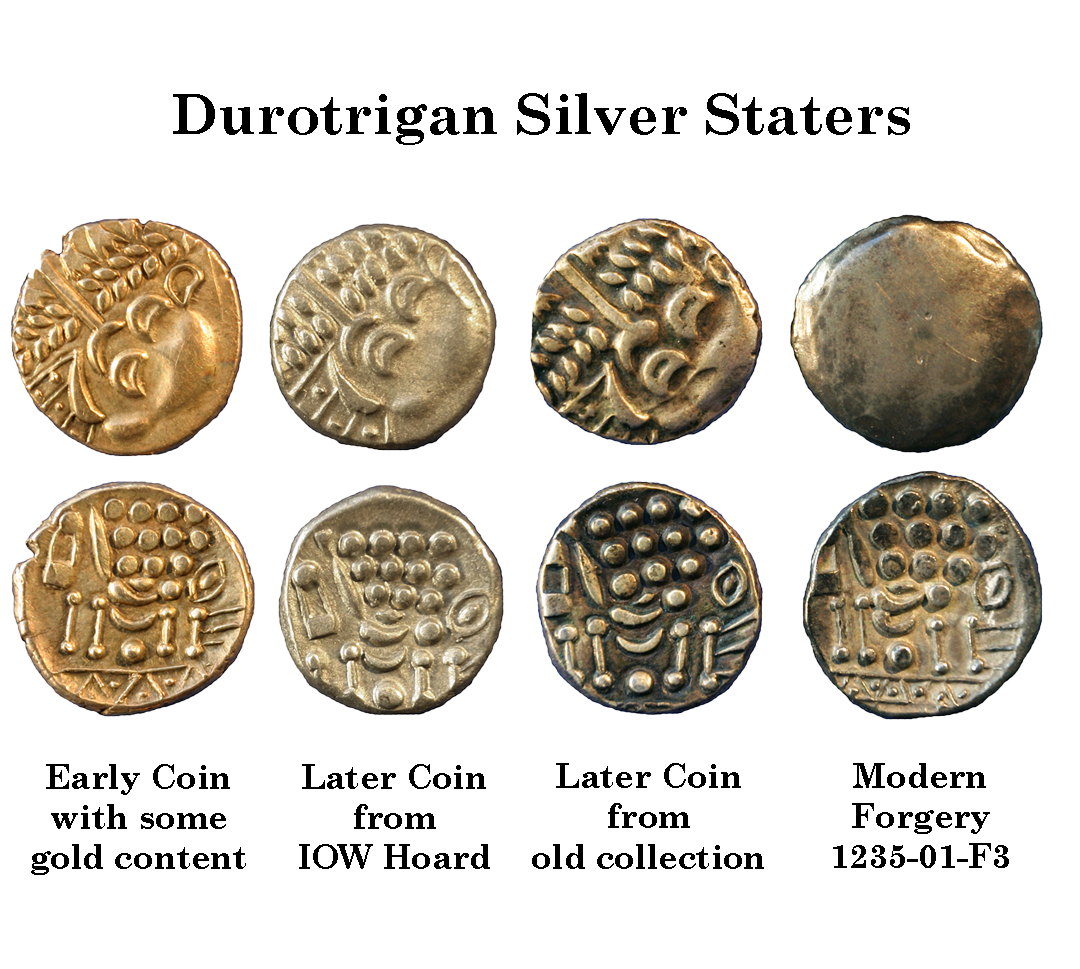
The four coins above were used in the latest analysis. The three genuine coins are all somewhat different, and the differences give authenticators useful diagnostics to keep in mind.
The first coin is not strictly a silver stater, but instead a Corfe Common Type. These lie metallurgically between the Chute Type (V1205) and the normal silver staters (V1235). In the Celtic Coinage of Britain catalogue, the Corfe Common Type is listed together with the normal silver coins, based on typology. One could argue it deserves to be treated as a different type, but that would require a metallurgical analysis just to attribute a coin. Corfe Common types typically have 9 to 15% gold content, but look like normal silver staters. Some may appear a bit yellower in colour, but this may not always be the case (NB: as always, the colours in the illustration should not be trusted) (info).
The coin used here is well struck and well preserved, faithfully showing the details of the die cutting and striking. It’s the best example to compare to the fake.
The second coin is a normal silver stater from the 2006 Isle of Wight Hoard (info). The coin has been heavily cleaned with chemicals and the surface is very bright.
The third coin is a normal silver stater that appeared in December 1978. Although it cannot be traced to an earlier publication, the coin had been coated with varnish long ago. It is thus likely to come from an old collection.
The fourth coin is the modern forgery.
The obverse of the fake
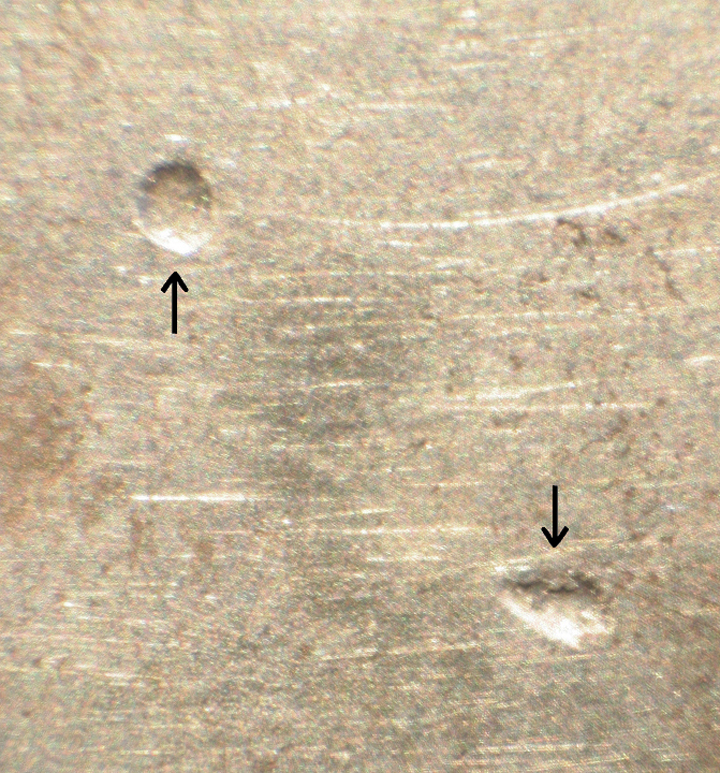
The obverse doesn’t provide any diagnostics for authentication, but does show some attempt at modifying the coin after manufacture. The coin doesn’t show any of the chemical treatment or antiquing work normally applied to fakes.
However, the obverse was lightly buffed to make it brighter. Parallel striations appear running horizontally in the photo, revealing the buffing process. Darker patches, where the buffing failed to reach, appear in low-lying areas. One of these is shown in the center of the photo.
The two depressions cannot easily be explained (arrows). One is circular and smooth, the other irregular and rough.
This is probably the best place to mention a well-known optical illusion. The relief of raised areas or depressions can appear reversed in photographs, such that a hole can look like a raised dot and vice versa. This optical illusion will sometimes make interpretation of the illustrations below difficult. Visual inspection with a stereomicroscope completely eliminates the problem.
The fields
The reverse field begins to show how the fake was made. At magnifications over 40x, most coins display a somewhat grainy or speckled appearance. However, differences in appearance can yield useful diagnostics for authentication. These differences are best seen using a stereomicroscope; photographs don’t do them justice.
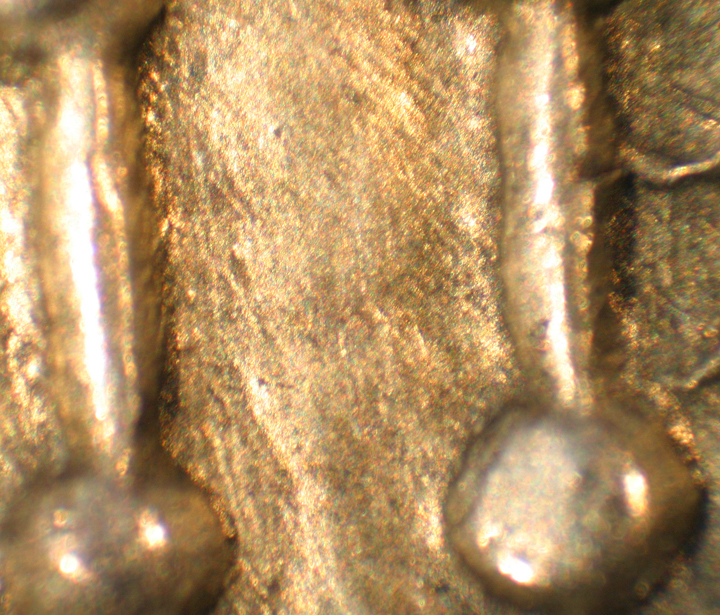
On the first coin (genuine, early type), the fields are relatively smooth but have minute scratches and fine striations. These marks could have been caused long ago by normal circulation wear. They could also be modern marks produced when the finders wiped the dirt off the coin.
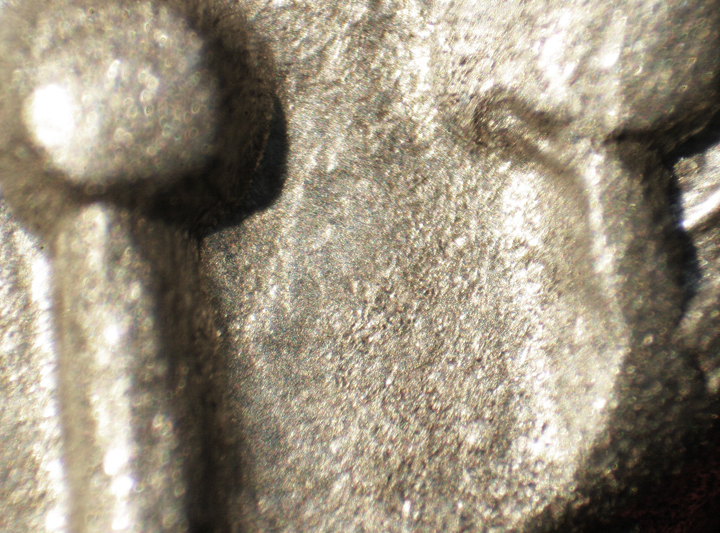
The second coin (genuine, IOW Hoard) is different. Its surface is cratered with tiny pits, ones that cannot be seen with a 10x loupe. The pits are easily visible in stereo at 45x, however. They often have dark centres.
This cratered surface is common for coins that have been severely over-cleaned with chemicals. It does not automatically condemn a coin that otherwise looks genuine – it merely means the coin has been cleaned too much. But it must be kept in mind that forgers use the same chemical treatment to hide their errors.
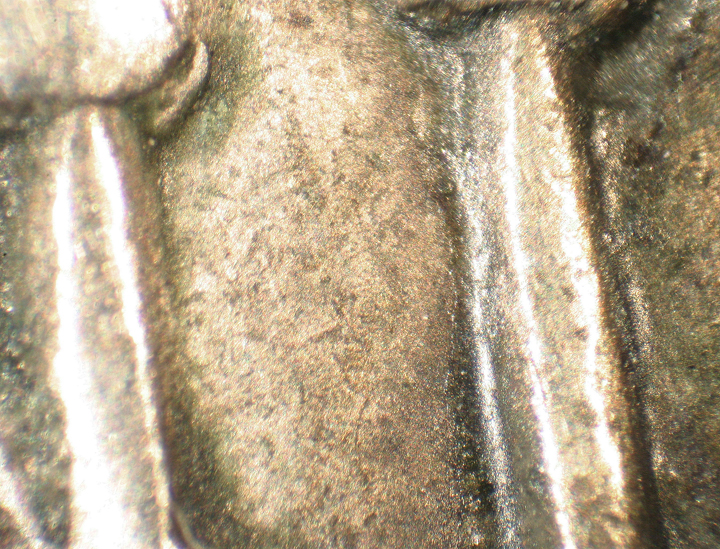
The third coin (genuine, old collection) has been coated with varnish long ago. The varnish has formed uneven blobs and streaks on the field. The coin’s surface is relatively smooth, however. Thus, the presence of the varnish has given a false interpretation of the field.
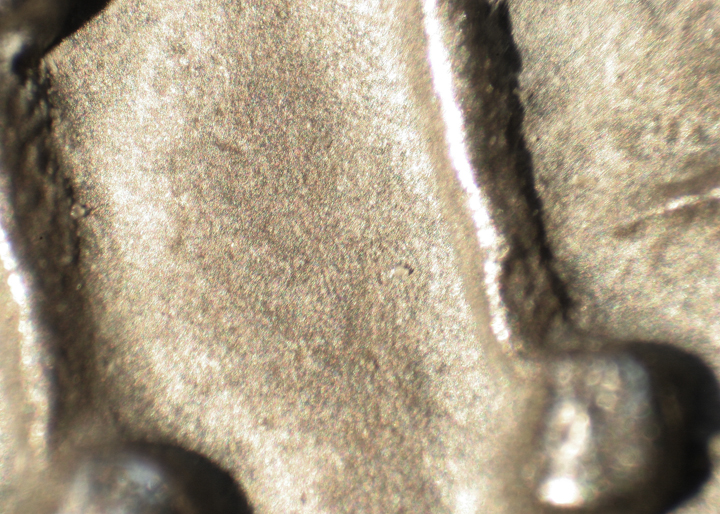
The fake looks different from all three of the genuine coins. It has not been chemically treated, and the fields show no sign of abrasion. At 10x magnification, the surfaces look perfectly smooth. But at 45x, they show a very even, granular surface. Uniform raised dots appear over the entire area between the legs of the horse, for example.
This granular surface suggests that the coin is either a cast fake, or a struck coin made using dies produced by a casting process. If the coin itself was cast, it was a very fine casting and an impressive piece of work.
Flow lines on the fields and pellets
Struck coins often display fine striations in the fields or on the sides of the raised elements. These are the result of abrasion of the dies as they are used. Metal flows across the surface of the die and down into the engraved areas, causing fine lines to appear. A well-struck coin will usually reveal this die damage somewhere.
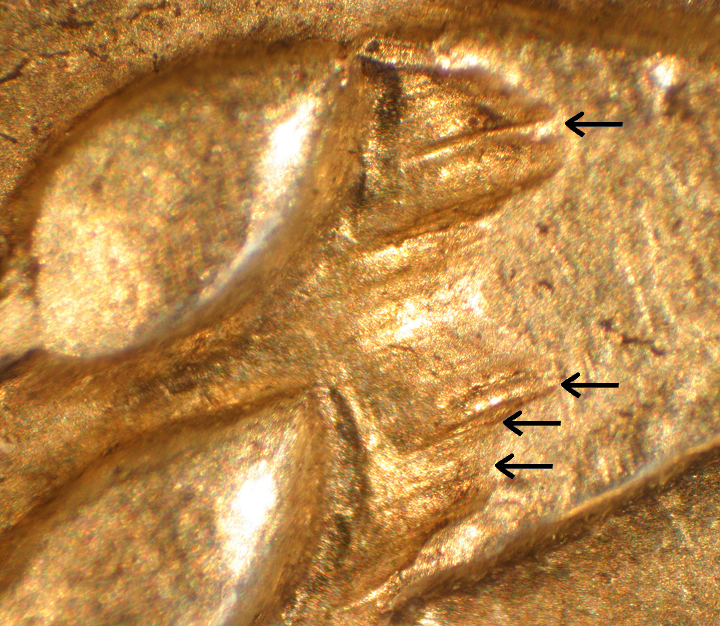
The obverse of the first coin (genuine, early type) shows fine striations in the field near the wreath (arrows). The die has been abraded from use and the result is seen as a raised, striated area on the coin.
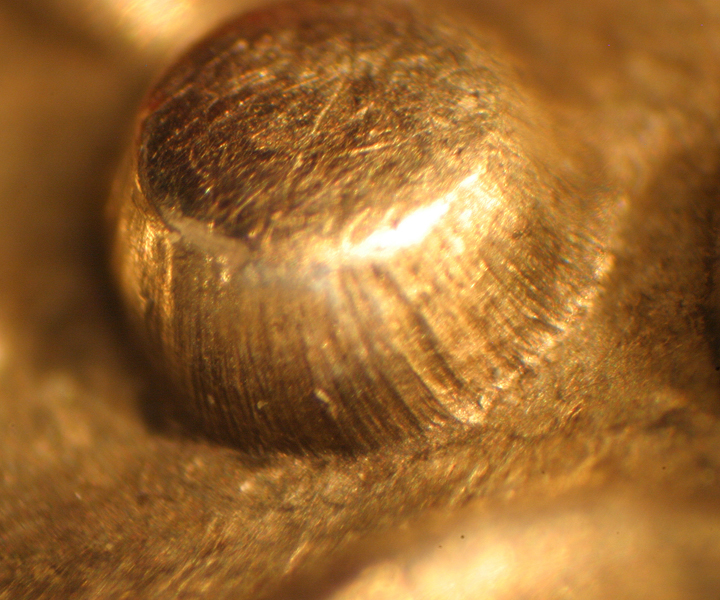
On the reverse of the same coin, fine striations run vertically on sides of the pellets. Note carefully that the junction of the pellet and the field is sharp and distinct.
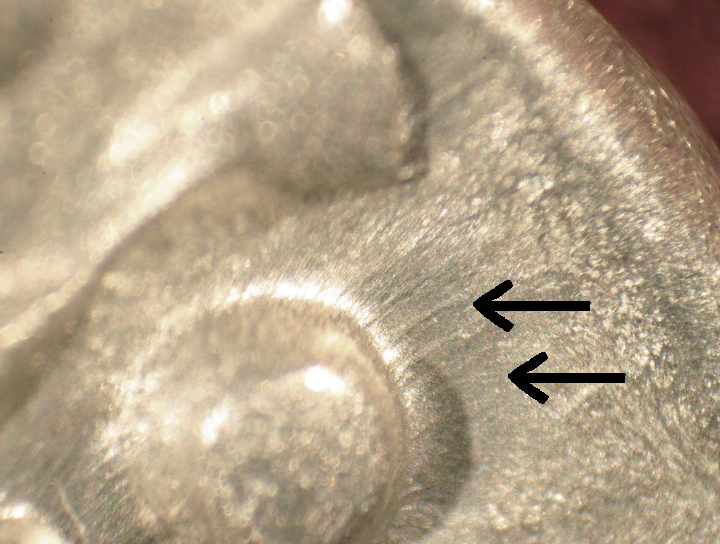
The heavy chemical treatment of the second coin (genuine, IOW Hoard) has obliterated most of these striations. They helpfully survive on the side of one pellet (arrows). If the coin had been treated any more, these striations might have been eroded away entirely.
Thus the absence of striations is not proof of a cast forgery. It is a diagnostic that can help build a case for condemnation, however, where the coin has not been subjected to severe chemical treatment.
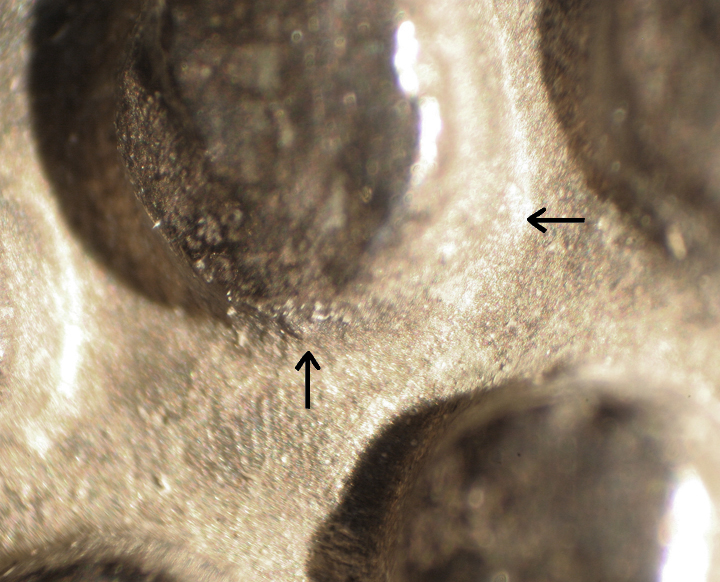
The fake shows no fine striations whatsoever. The sides of the pellets have the same granular surfaces as the fields (lower arrow). Furthermore, the pellets have very blurred junctions with the field (upper arrow).
Die breaks
Die breaks and broken areas on dies usually produce sharp jagged areas on the coins. These details are difficult of reproduce faithfully, when fakes are cast.
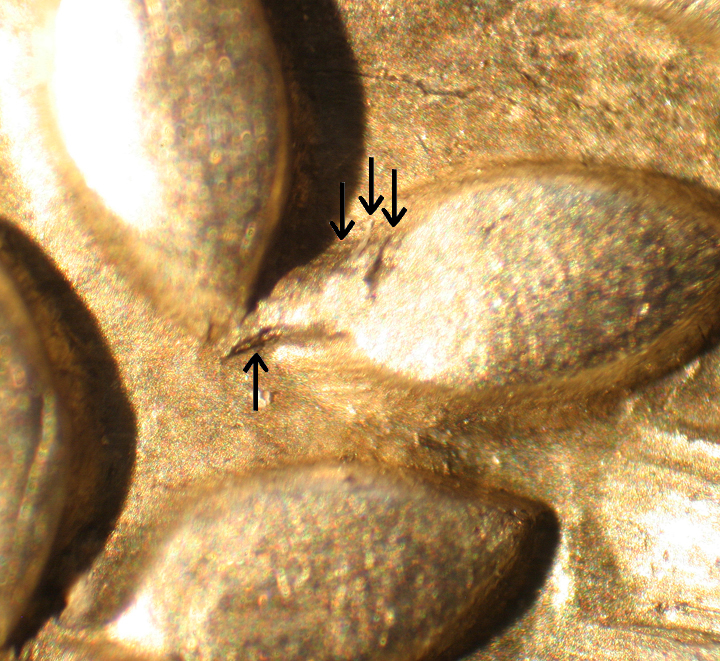
On the first coin (genuine, early type), the die was beginning to break down between two of the laurel leaves on the obverse. The striking process has faithfully recorded the jagged, broken area of the die as a raised area (arrows).
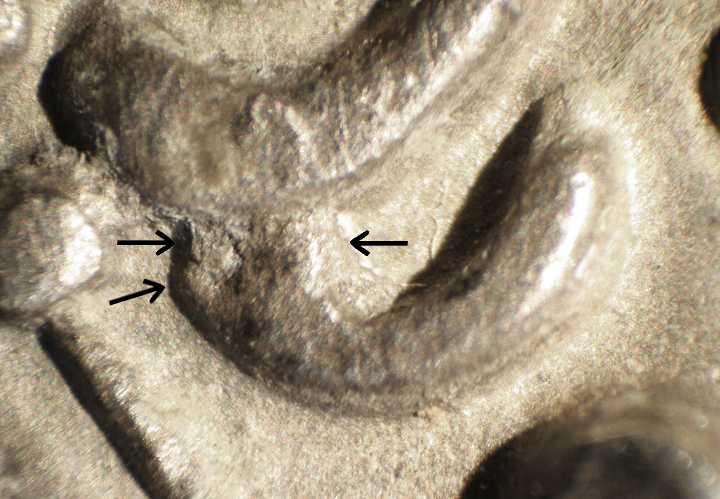
The modern fake was likely produced using a genuine silver stater as a mother coin. The die of the original ancient coin had broken between the curved lines of the horse’s body. This raised area (caused by the die break) would have been sharp and jagged on the mother coin.
On the fake, however, this raised area is blurred and indistinct (arrows). A casting process, either to produce a cast die, or to cast the fake coin directly, has failed to faithfully reproduce the die damage.
Summary
Thus, the modern fake can be detected visually if sufficient magnification is used. Viewing in stereo greatly enhances the appearance of the flaws.
There are several possibilities:
- The fake could have been cast directly in a mould.
- Fake dies could have been made using a casting process, and a coin struck from these.
The casting is a very good one, suggesting a third possibility:
- The fake was produced using a sintering process, in which fine granules of metal are fused in a mould under heat and/or pressure.
It is possible that a metallurgical or metallographic analysis could reveal the exact method used, but the coin can be condemned without taking this extra step.
Metallurgical analysis of the forgery:
| Coin | V1235-01-F3 | |
| Weight | 3.8639 gms | |
| Au | 5.46% | |
| Ag | 86.14% | |
| Cu | 6.33% | |
| Fe | 0.03% | |
| Co | trace | |
| Ni | 0.01% | |
| Zn | 0.05% | |
| As | – | |
| Bi | – | |
| Sb | 0.15% | |
| Sn | 1.19% | |
| Pb | 0.60% |
End
